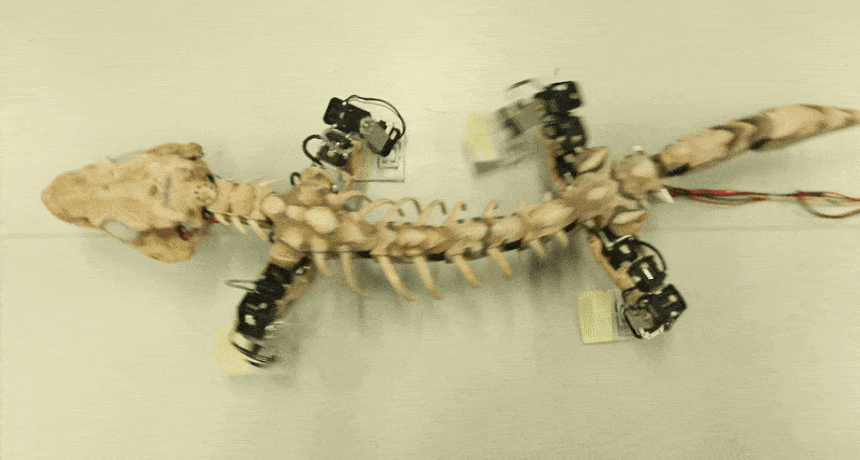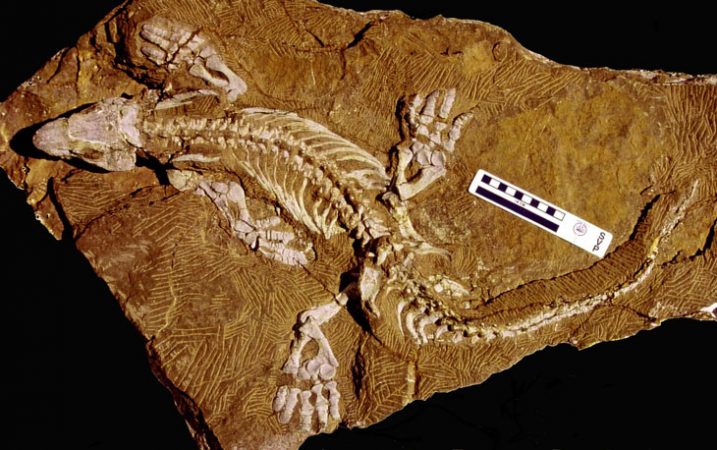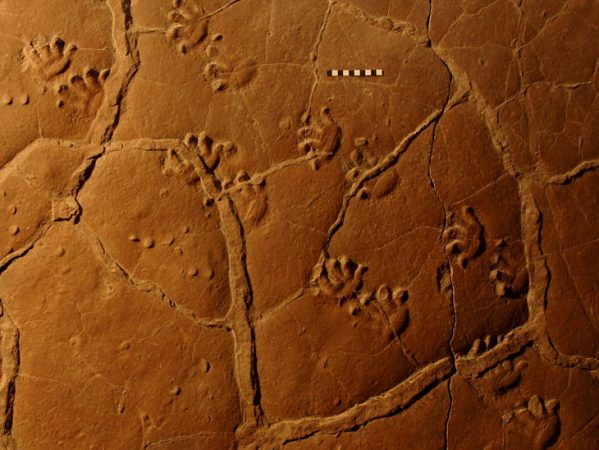This robot shows how an ancient creature might have walked
The 290-million-year-old animal that left this fossil didn’t slither like a salamander after all

Researchers built a robot called OroBOT to re-create the way that Orobates pabsti might have walked. That four-legged creature lived some 290 million years ago.
Tomislav Horvat and K. Melo/EPFL Lausanne
An ancient four-footed critter stomped around what is now Germany some 280 million to 290 million years ago. One of the earliest creatures to live fully on land, it was pretty good at trekking about, a new study finds. For their study, researchers relied on computer simulations, imitation skeletons and fossil footprints. They even built a walking robot —the OroBot — to find out how the creature likely moved. The results suggest that efficiently walking upright evolved earlier than researchers once thought.
The scientists started with fossil evidence of Orobates pabsti (Oh-roh-BAY-tees PAB-sty). It was one of the earliest amniotes (AM-nee-oats). And unlike amphibians, which have young that must live in the water, amniotes can live entirely on land. Amniotes first arose some 350 million years ago.

Membranes surrounded their developing young. This allowed amniotes to walk away from a tadpole-type life stage in the water. Reptiles and birds instead surround their embryos with an egg. Most mammal embryos grow inside their mother.
This amniotic membrane was key to allowing early reptiles to leave the water and thrive in drier habitats, says John Nyakatura. He is a paleontologist — someone who studies fossils — at the Humboldt University of Berlin, Germany. He also led the new study.
Learning how early amniotes walked on land could help scientists better understand their evolution from earlier creatures. It also could help explain how amniotes spread globally, Nyakatura says — eventually becoming reptiles, birds and mammals. “Orobates, our focus fossil in this story, is a very close cousin to the last common ancestor of mammals and reptiles,” he explains.
O. pabsti arrived on the scientific scene in 2004. In life, it looked like a large lizard around the size of an iguana. The first fossils showed up at a site in central Germany known as the Bromacher locality. Hundreds of millions of years ago, this site was in a valley between mountains. From time to time, when there was a storm, the valley would flood. Animals strolling through the area left footprints behind in the squishy mud. Sometimes, those animals might die there as well. Eventually buried in mud, they would begin the process of becoming a fossil. O. pabsti is one of the most complete fossils found at this site.
“These are things preserved from the tip of the nose to the tip of the tails,” notes Stuart Sumida. He is a vertebrate paleontologist, someone who studies only fossils with backbones. Sumida, who works at California State University in San Bernardino, was not involved in the new study. The new fossils “are so well preserved that we can generate [ideas] about how they moved,” he says.
The Bromacher locality doesn’t just have lovely fossil bones. It has fossilized footprints, too. A string of those footprints from the same animal is called a trackway. Scientists were able to link one trackway at the Bromacher locality to the O. pabsti fossil. Those tracks offered more clues to how the animal might have walked.

But there’s more to understanding walking than knowing where an animal put its feet. For instance, they might even build a robot, says Kamilo Melo. He is a bioroboticist — someone who studies robots that imitate living things. He works at École Polytechnique Fédérale de Lausanne in Switzerland. What’s unique about the new study, he says, is that the scientists have combined several of these tactics together. That way, they get the best possible understanding of an ancient creature’s gait.
And, Sumida adds, the German team confirmed something that only the fossil’s original finders suspected: O. pabsti lived its whole life on land — and walking instead of wriggling.
Reanimating a fossil’s source
To gauge how the animal might have moved, the researchers first re-created its skeleton. They used this to find out how far O. pabsti’s arms and legs could move. Explains Melo, they essentially created a puppet. Then the researchers tested the potential range of motion each joint might have. The scientists also used a computer model to find out how the animal’s body would move in response to gravity and the friction from the ground as it walked.
The scientists looked at species still scurrying around today, such as salamanders, skinks, caimans (reptiles related to alligators) and iguanas. They used these animals to imagine ways the ancient animal might have moved. Skinks and salamanders, for example, hold their bodies low. Their limbs sprawl out to the sides as their bellies slither on the ground. Caimens tend have limbs that push their bodies up, holding them higher off the ground.
The scientists then crafted a robot based on what they learned from the fossil, footprint tracks, skeleton, computer model and other species. Called the OroBOT, it demonstrated potential gaits. It matched the footprint trails the scientists had.
Eventually the researchers considered 512 different possible types of movement. They scored each on how much energy they needed, how well the robot balanced and how well the gait matched the tracks without slipping. (The researchers have also put their computer model online; you can try it out.)
The results suggest that O. pabsti had a relatively advanced style of walking. It’s one that researchers thought hadn’t evolved until much later.
The creature would have had a stable, efficient gait — one without a lot of side-to-side, salamander-like wiggles. It also would have held its belly off the ground. This gait likely helped it conserve energy. Melo, Nyakatura and their colleagues describe their findings January 17 in Nature.
Sumida praised the many ways the scientists tested their findings from fossil to computers to a robot. He and others have shown that amniotes from the same area walked in several different ways. Some had limbs that lifted them off the ground like O. pabsti. Others sprawled. At least one animal walked on two legs. “What these studies are showing is that when amniotes first showed up, they were doing lots of things more quickly than we ever realized,” he says.
And these findings are just a start, Nyakatura says. The researchers hope their approach helps scientists better understand how other ancient animals got around. He’s interested in how animals launched into the air, stood up on two legs and even went back into the sea (as did the whales and seals we know today). “We have a whole bag of interesting things to study,” he says.
First clip: Kamilo Melo and Tomislav Horvat/EPFL Lausanne, SAVE/EPFL, Second clip: Tomislav Horvat and Kamilo Melo/EPFL Lausanne







